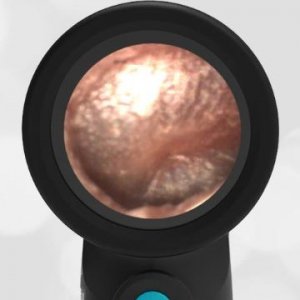
Shagrination or “Cobble Stoning”
A 16-month-old toddler presented to the emergency department with three days of nasal congestion and low-grade fever. The child had been otherwise well with only a mild cough. Due to a respiratory syncytial virus (RSV) exposure at daycare, his mother brought him for evaluation. His respiratory exam was reassuring with only the occasional mild wheeze and no increased work of breathing. Examination of the left ear revealed this finding.
This patient has the classic appearance of shagrination or “cobble stoning” of the tympanic membrane (TM).
The roughened appearance, shagrination (cobble stoning) of the TM is thought to occur during the course of acute otitis media (AOM) as the bulging membrane begins to return to its normal position as fluid in the middle ear recedes. While the exact pathophysiology is not clear, this finding reminds us that the TM is not a single homogeneous band of tissue but rather a multi-layered complex composed of epithelial (continuous with the external canal), fibrous (middle radial layer), and mucosal (continuous with the lining of the middle ear) cells.
Armengol and Handley published images of 17 children with AOM who either developed or presented with shagrination1. Follow-up images indicated that resolution of bulging typically occurred within the 1-2 days, suggesting that shagrination indicates the decompression of the middle ear space (think of the wrinkles in a deflated balloon) with a resolution likely to occur soon thereafter. Here is another example of shagrination.

Shagrination – cobble stoning additional view
As can be attested by many of the Wispr cases, the use of digital otoscopy facilitates not only the diagnosis of AOM but also provides opportunities to evaluate the significance of physical findings. In the Armengol paper, digital otoscopy demonstrated resolution of AOM findings within 1 to 2 days following the appearance of cobblestoning, including in three patients who did not receive antibiotics. While further studies in a larger cohort will be helpful, this suggests that the appearance of shagrination may herald spontaneous resolution and allow antibiotics to be avoided or curtailed in these patients. For further information, here is a case study of resolving AOM. In this study, shagrination appears on day 8.
Here is the complete video exam from this patient.
Complete exam video
- Armengol, CE, and Hendley, JO, “Shagrination during Acute Otitis Media,” The Journal of Pediatrics, 2014;165:870.







































































































































































































